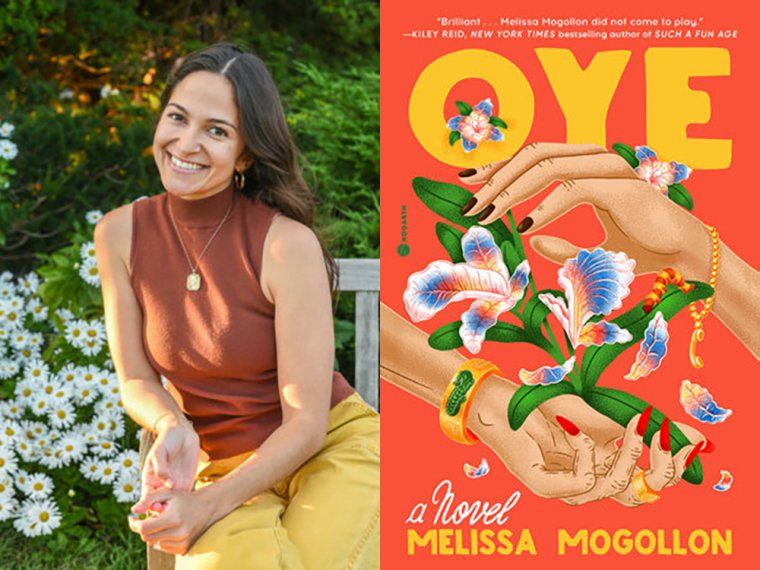This week’s installment of Ten Questions features Melissa Mogollon, whose debut novel is out today from Hogarth. In this formally inventive tale, the plot unfolds through one side of a series of phone conversations between protagonist Luciana, a Colombian American high school senior, and her older sister, Mari, who is away at college. In her brash and playful voice, Luciana by turns cajoles, confronts, and regales her sister with the drama of teenage life both out in the world and at home. Family dynamics have become particularly challenging for Luciana, who finds herself sharing a bedroom with her sick grandmother, Abue. While the two have long been close, Luciana is nonetheless stressed by her role as caretaker. Luciana also must deal with her mother, Elena, who is at odds with Luciana not only about how to treat Abue but about how to live her own life: Elena is not exactly thrilled about her daughter’s recently announced queerness. Meanwhile Luciana learns more about her grandmother’s past, unravelling a troubling history that reframes her understanding of her family. Publishers Weekly praises Oye, saying the book “manages to convey the fierce love that binds the women across generations. When they finally arrive at varying degrees of acceptance, it feels inevitable rather than contrived. Mogollon wows with tenderness and uproarious profanity.” Melissa Mogollon holds an MFA from the Iowa Writers’ Workshop. Originally from Colombia and raised in Florida, she now teaches at a boarding school in Rhode Island, where she lives with her partner and dog.

Melissa Mogollon, author of Oye. (Credit: Joy Imani Bullock)
1. How long did it take you to write Oye?
About two years of writing total—spread out over the course of four to five years.
2. What was the most challenging thing about writing the book?
Crafting a way to demonstrate the difference/tension between what my protagonist was thinking versus what she was actually saying—since it’s all told in [her side of a] dialogue.
3. Where, when, and how often do you write?
I work at a boarding school full-time now, so I’m only able to write on breaks: winter, spring, summer, weekends, etcetera. But while I was finishing and editing Oye, I had the privilege of being able to write full-time, so I was basically writing and revising every weekday from about 10:00 AM to 6:00 PM. And then I’d take around a month off between drafts. Sometimes my ADHD was really helpful with its hyper-focus and tunnel vision, but other times the indecision about a word or comma could keep me on the same page for days.
4. What are you reading right now?
I’ve started reading Cinema Love by Jiaming Tang, Victim by Andrew Boryga, Broughtupsy by Christina Cooke, There Is a Rio Grande in Heaven by Ruben Reyes Jr., and Hombrecito by Santiago Jose Sanchez—so much 2024 debut goodness. These are all sitting on my coffee table waiting for summer.
5. Which author or authors have been influential for you, in your writing of this book in particular or as a writer in general?
Omg. So many. Julián Delgado Lopera’s Fiebre Tropical, Randa Jarrar’s A Map of Home, all of Jennine Capó Crucet’s writing, but especially How to Leave Hialeah; the same with Melissa Lozada-Oliva, but particularly Dreaming of You and Candelaria. Then: Hache Carrillo, Alexander Chee, Ilya Kaminsky, Ross Gay, Kristen Arnett, Myriam Gurba, Jamil Jan Kochai, Dawnie Walton, Kiley Reid, Kaveh Akbar, Margot Livesey, and Natalie Diaz.
6. What is one thing that surprised you during the writing of Oye?
That [the problem with] writing with ADHD is not that you don’t finish the book. It’s that you write the same book eight different ways. Indecision and perfectionism are dangerously close!
7. What is one thing your agent or editor told you during the process of publishing this book that stuck with you?
The editor who we sold Oye to ended up leaving the publishing industry a few months into editing, and I was devastated. I told the new editor who I was reassigned to, Clio Seraphim, that I felt like I had lost Oye’s “mom,” or its biggest champion. Clio very kindly listened to me and let me know that, while she understood, Oye actually had many other “moms” in the background who were working on and rooting for it the whole time; it felt entirely natural and exciting for her to step into the role of “primary mom.” I was really touched by that. Clio did not owe me or the book anything. But she took Oye on as if she had wanted it and bought it herself. I’ll be forever grateful to her for that.
8. If you could go back in time and talk to the earlier you, before you started Oye, what would you say?
Make. A. Freaking. Outline.
9. What forms of work, other than writing, did you have to do to complete this book?
I shockingly got very into weightlifting while editing and revising Oye. I had never done something like that before, but I found that developing a new source of strength was awesome. It helped me do something, somatically, with all the jitters and adrenaline that I was building up every day from writing. And feeling physically strong and capable helped me push through the harder mental days while finishing the book. I also went to a lot of comedy shows. So fun. Laughing is important. And obviously I walked my dog—the cutest animal in the world.
10. What’s the best piece of writing advice you’ve ever received?
As a writer, sometimes it’s better to lean into your strengths instead of trying to make up for your weaknesses. Sometimes the story needs that.







